History of Ponte Nizza and its hamlet

 Ponte Nizza is a commune arose in 1929 after the join of three old towns: Pizzocorno, Trebbiano e S. Ponzo. This commune, placed in the middle of Staffora valley and in the lower of Nizza valley. The altitude is 265 meters s.l.m. Ponte Nizza is surround of grass and maize fields and of orchard. It's a modern town. Ponte Nizza is a commune arose in 1929 after the join of three old towns: Pizzocorno, Trebbiano e S. Ponzo. This commune, placed in the middle of Staffora valley and in the lower of Nizza valley. The altitude is 265 meters s.l.m. Ponte Nizza is surround of grass and maize fields and of orchard. It's a modern town.
San Ponzo is a Ponte Nizza's hamlet. It's charm and isolate town like in the past times. During the Roman time in S. Ponzo lived many Christian refugees, one of they is San Ponzo.
San Ponzo lived in a cave placed in the same town. From 1903 his remainses are in San Ponzo church. The front of the church is in Romanic style and the bell tower has square base. Probably the oldest part of the church is the presbytery. The church was restore in 1435 and many of the original structure were lost.
Trebbiano is a Ponte Nizza's hamlet. There are small house's groups surrounded of fields and of orchard.
Pizzocorno is another Ponte Nizza hamlet. It erected on a degraded slope of Cornato mount and there are few houses.
Trebbiano and Pizzocorno's history tie together with the history of Sant'Alberto abbey. In medieval time this abbey has many fields and feuds.
 The most important activity in Sant'Alberto's hamlet is the agriculture. Sant'Alberto abbey is an artistic-architectonic masterpiece and it calls "the
Oltrepò
pearl". The most important activity in Sant'Alberto's hamlet is the agriculture. Sant'Alberto abbey is an artistic-architectonic masterpiece and it calls "the
Oltrepò
pearl".
Alberto, hermit monk, in XI century found the abbey on the remain of an old Roman fortification. This abbey composes of four sacred buildings communicanting. The abbey was visit to many important people like Barbarossa and Edward II. In the XVI century pope Leone X joined the abbey with San Bartolomeo in Strada abbey. After this Sant'Aberto abbey lost its importance but in 1921 Don Orione underline its importance. In XX century the most important person into the abbey was the hermit blind friar Ave Maria.
|